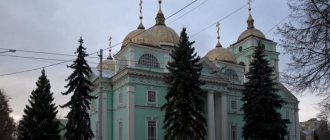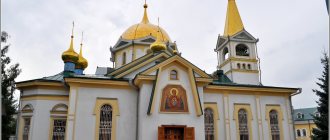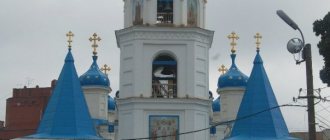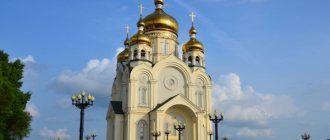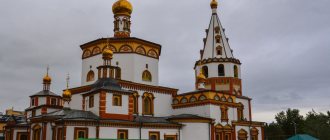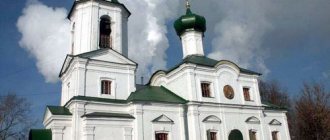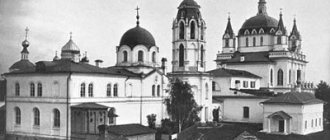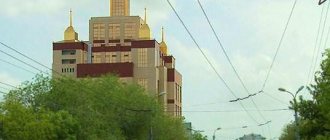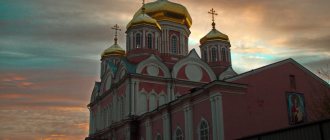It is known that from ancient times in Rus' there was a custom to build temples in gratitude to the Lord for the earthly blessings sent down to him. In distant centuries, such builders were princes and boyars, then they were replaced by the noble aristocracy, merchants and representatives of the rapidly developing class of entrepreneurs that appeared in the country - yesterday's peasants. An example of such construction is the Ivanovo-Uspensky Cathedral.
Temple of Ivanovo Weavers
In 1834, a temple was founded on the territory of the cemetery belonging to the village of Ivanovo, which is located on the banks of the Uvod River. It was built on the initiative and with the money of local peasants Nikolai Stepanovich Shodchin and his fellow villager Kosma Ivanovich Butrimov. They had a lot to thank God for - coming from Old Believer families, they founded their own manufactories, which in a short time became one of the most famous weaving enterprises in Russia.
The development of the project was entrusted to the provincial architect E. Ya. Petrov, thanks to whom the Assumption Cathedral (Ivanovo) became one of the remarkable examples of temple buildings in the style of late classicism. The generous contributions of the initiators of the construction made it possible to decorate it with rich interior decoration.
Monument of past centuries
The Assumption Church in Ivanovo, where only charred logs remain today, was built at the end of the 16th century. The builders based its design on a wooden frame-cage, which gave modern art historians the basis to classify it as a cage-type temple building, a term used in the history of architecture. In ancient years, buildings such as the Assumption Church in Ivanovo were widespread throughout the region.
On the site where the city Palace of Arts is located today, five centuries ago there was the Intercession Monastery. This church was built on its territory, only it was then called Trinity. The first mention of it is found in documents dating back to 1632, that is, during the reign of the first tsar from the House of Romanov, Emperor Mikhail Fedorovich.
Generous philanthropist
A year after the start of work, Nikolai Stepanovich Shodchin died, but his work was continued by his son and heir, Anton Nikolaevich. This man was a bright and extraordinary personality. Having continued and developed his father's business, he managed to amass a multimillion-dollar fortune, constantly donating money to numerous homeless shelters, hospitals and almshouses.
A curious detail - few people know that the Orthodox St. Nicholas Cathedral on 97th Street in New York was built precisely with the money of the Ivanovo peasant Anton Nikolaevich Shodchin, who expressed his will in his will and allocated the necessary funds.
Transfer of the church to the Old Believers
But that was still a long time away. And in 1939, the authorities committed the usual blasphemy at that time - they set up an anti-religious museum in the Temple of God, sending the previous exhibitions to another room. It existed until the war itself - when bombs began to fall on Russian soil, the authorities had no time for atheism. It is known that in order to raise the spirit of national self-awareness among the people, Stalin made some concessions regarding religion.
The Assumption Church in Ivanovo was transferred to the Old Believer community, a church council was registered there, but regular services were resumed only in 1946. From that time on, the temple officially belonged to the Belokrinsk Old Believer hierarchy. It was consecrated again, this time in honor of the Kazan Icon of the Mother of God. Until its last day, the Assumption Church (Ivanovo) belonged to the Ivanovo-Voznesensk diocese of the Russian Orthodox Church as a co-religionist of the old rite.
Consecration of the temple and donation of a miraculous icon to it
The Assumption Cathedral of the city of Ivanovo took nine years to build. Its consecration took place in the fall of 1843. Since the cathedral had three chapels, the celebration lasted for three days. The main altar was consecrated on September 19 in honor of the great holiday - the Dormition of the Blessed Virgin Mary, and the rest - in the following days. They were dedicated to the Great Martyr Barbara and the Nativity of John the Baptist.
In those same days, another Ivanovo peasant manufacturer, V. A. Grachev, donated to the cathedral the icon of St. John the Baptist, which had until then been kept in his house, which became one of its main shrines. This image, which became widely known due to the numerous miracles revealed through prayers before it, attracted a large number of pilgrims to the cathedral, both local and from other cities of the country.
Current status and visiting hours
More than 25 inhabitants live in the church and its farmsteads . Today, her main focus is active ministry. The monks help poor city residents and displaced people, constantly visit city hospitals and visit orphans. In addition to all this, the monastery runs courses for parishioners, a scout movement, a bishop’s choir has been created, and a youth movement is actively developing.
The area of the monastery is more than 3 hectares. The entire territory of the monastery is surrounded by a high brick fence. It is open to the public every day from 10 a.m. to 5 p.m. Where many years ago there was a cemetery in memory of the dead, there is a worship cross. Instead of the destroyed bell tower, a memorial chapel has stood in the monastery courtyard since 2002. A couple of years ago, the construction of the fraternal building, which occupies as many as four floors, was completed.
On October 23, 2021, Metropolitan Joseph of Ivanovo-Voznesensk and Vichug solemnly welcomed the ark with the belt of the Most Holy Theotokos in the Assumption Cathedral in Ivanovo.
Serf family from Ivanovo
The Assumption Cathedral was not only built with peasant money, but its further splendor was also supported by people from the very bottom of the social ladder - the Shchapov serf family. Its head, Terenty Alekseevich, managed to open his own business and became the founder of the famous Ivanovo dynasty. In 1843, immediately after the consecration of the cathedral, he took charge of the improvement of the adjacent territory and its splendor.
For many years, the pious industrialist Terenty Alekseevich was the head of the cathedral, and after his death, his son Nikolai Terentyevich began to fill this position. Having material wealth, the Shchapov family, using their own funds, regularly carried out the work necessary to maintain the internal and external splendor of the Assumption Cathedral in the city of Ivanovo.
It is known that Nikolai Terentyevich personally financed the painting of the temple, for which craftsmen were invited from Moscow, and paid for the installation of new domes of the cathedral, as well as the construction of a stone church fence. At the same time, he and his wife Sofya Mikhailovna paid great attention to raising their own children, of whom they had fifteen. The fate of each of them developed differently, but they all grew up to be true believers and pious people.
History[edit]
Before the revolution, in the city of Ivanovo-Voznesensk there were three majestic temple complexes: the Intercession and Trinity Cathedrals with a bell tower on Pokrovskaya Hill (the current territory of Pushkin Square), the Holy Cross and Nativity Churches with two bell towers on Torgovaya Square (the territory of modern Revolution Square) and the Ascension Church with a bell tower in the center of Voznesensky Posad. All of them, together with the ancient cemeteries of the village of Ivanovo and Voznesensky Posad located next to them, were destroyed in the 30s. Atheists destroyed or closed other churches in Ivanovo-Voznesensk.
During the years of persecution, only the small Transfiguration Church of the village of Rylikha, a settlement that became part of Ivanovo-Voznesensk after the 1917 revolution, survived. It remained the only functioning church, and after 1944, out of necessity, it became the cathedral of the Ivanovo diocese. Several generations of Ivanovo residents knew this temple under the name “White Church”.
This majestic temple was founded exactly 180 years ago, on September 12, 1834, on the territory of the Assumption Cemetery in the village of Ivanovo, which arose half a century earlier.
Pre-revolutionary view of the Assumption Church
The design of the temple was developed by the Vladimir provincial architect E.Ya. Petrov. It was built at the expense of Ivanovo manufacturers - peasants Nikolai Stepanovich Shodchin and Kosma Ivanovich Butrimov. The Assumption Church was completed at his own expense by peasant Anton Nikolaevich Shodchin. The church was built in the traditions of late classicism.
On September 19, 1843, with the blessing of Bishop Parthenius of Vladimir and Suzdal, the rector of the Vladimir Theological Seminary, Archimandrite Polycarp, consecrated the main altar of the church in honor of the Dormition of the Blessed Virgin Mary. On September 20 and 21 of the same year, local dean Archpriest Vasily Narbekov consecrated chapels in honor of the Nativity of John the Baptist and the Great Martyr Barbara.
The name of the first of these chapels is due to the fact that the home shrine of the wealthy Ivanovo peasant entrepreneur V.A. Grachev - the icon of the Forerunner and Baptist of the Lord John - was transferred to the Assumption Church.
Thanks to the major contributions of A.N. Shodchin, the temple had a very rich interior decoration. All the icons in the iconostasis were in rich forged silver frames. In 1922, during the confiscation of church valuables from the Assumption Church, theomachists confiscated 18 pounds (288 kilograms) of silver.
Before the consecration of the temple in 1843, the Shchapov family of serfs used their own funds to tidy up the territory of the adjacent Assumption Cemetery. Then, for almost half a century, the serf peasant, founder of the entrepreneurial dynasty Terenty Alekseevich Shchapov and his son Nikolai Terentyevich Shchapov were active elders of the Assumption Church. Their duties included maintaining the splendor of the temple. This was often done at the personal expense of the headman.
Nikolai Terentyevich Shchapov was appointed to the position of head of the Assumption Church by the Ivanovo-Voznesensk City Duma and worked in this obedience for 25 years, the same as his father. At the same time, he was an example of an Orthodox Christian. Nikolai Terentyevich lived together with his wife Sofya Mikhailovna for 53 years. They had 15 children.
The Shchapov family adhered to Orthodox family values: a modest lifestyle, strict upbringing of children, charity. Boys studied at the Ivanovo-Voznesensk real school, where the basic knowledge necessary for the business life of a merchant was taught, girls studied at the gymnasium. Nikolai Terentyevich raised his children in the Orthodox and merchant traditions. Dress modestly, attend church, honor your elders. The large house of the Shchapovs now houses the Ivanovo Agricultural Academy.
Temple after closing
Under Nikolai Terentyevich Shchapov, the Assumption Church was completely painted. New domes were installed on the temple, and a cemetery fence was built. In 1903, by order and at the expense of Nikolai Shchapov, the Trinity Chapel was built at the Lower Bazaar, which was then destroyed during the Soviet years.
In addition, Nikolai Terentyevich was the headman of the Resurrection Church in the village of Ermolino (now Furmanovsky district). Nowadays the Resurrection Monastery is located here - Ermolinskaya Hermitage. In 1905, Nikolai Shchapov built a parochial school in Ermolino.
Nikolai Terentyevich Shchapov and his family suffered during the Soviet years. A huge family of former serfs was deprived of their home. Nikolai Ivanovich's children went through prisons and exile. In September 1928, Sofya Mikhailovna Shchapova died. She was buried in the family crypt near the bell tower of the Assumption Church. Four years earlier, the Orthodox community was expelled from the church, and its place was taken by schismatic renovationists.
In the fall of 1933, the Assumption Church was closed, grave monuments and mounds in the cemetery were eliminated - despite the fact that burials took place there until the very last moment. A dance floor was built right on the former graves, and the cemetery itself was turned into the Melangist garden with a summer cinema and a reading room. People now call this place “the park of the living and the dead.”
In the pre-war years, the temple was adapted into housing for workers, dividing the building with wooden partitions into rooms located on both sides of a long common corridor. 49 families, almost 180 people lived here. Even in the altar there were two apartments. The temple was stripped of its domes, porticoes and bell tower. In 1949, residents were resettled in dormitories, and since 1950, the Ivgorelektroset enterprise was located in the church.
The question of returning the temple to the Russian Orthodox Church was raised back in 1991. By the decision of the Holy Synod on April 9, 1998, the Assumption Monastery was opened here, to which the territory of the former cemetery was transferred. It was only in October 2003 that the last division of Ivgorelektroset was transferred from the Assumption Church to new premises.
Since 2007, restoration of the interior space and appearance of the temple began. In April 2013, at a joint meeting of the leadership of the diocese and the region, it was decided in the future, after the completion of the main part of the restoration work, to give the status of a cathedral to the restored Assumption Church in the city of Ivanovo. The temple acquired the status of a cathedral on August 28, 2014.
On July 21, 2015, during his visit to the Ivanovo-Voznesensk diocese, His Holiness Patriarch Kirill performed the great consecration of the Assumption Cathedral.
The blasphemies of the ungodly government
Unfortunately, in the years following the Bolsheviks’ coming to power, both the Ivanovo-Assumption Cathedral itself and the family of peasant entrepreneurs, who had sacrificed their strength and resources for more than half a century, suffered for its splendor. The new government kicked the Shchapov family out of their spacious home, and soon the children - all fifteen of them - were arrested, and spent the following years in prison, never understanding what their guilt was. Sofya Mikhailovna died of grief in 1928, only slightly outliving her husband.
In 1933, by order of the City Council, the Ivanovo-Uspensky Cathedral was closed. His community was abolished, and those who tried to object were arrested. If this ungodly action could still be explained by the general course of the government of those years, then the blasphemy committed against the cemetery where the cathedral was located causes complete bewilderment. Despite the fact that until the last moment burials continued there and there were many fresh graves visited by the relatives of the deceased, the cemetery was razed to the ground, and a dance floor was built in its place.
At Novo-Posadsky churchyard
On his initiative, the building was again dismantled and transported to another city cemetery - Novo-Posadskoye. Here it was not only reassembled in its original form, replacing rotten logs with new ones, but also a bell tower was attached to it. In January 1906, in the presence of a large number of parishioners and all eminent residents of the city, the church was solemnly consecrated.
Cathedral divided into cages
The Assumption Cathedral itself (Ivanovo) was converted into a dormitory, and for this purpose the entire interior was partitioned with plywood walls, dividing it into square meters of living space allocated by the authorities to the owners of the new life. The domes, bell tower and porticoes were demolished as not meeting the new purpose of the building. At the end of the forties, the workers were resettled in other dormitories, and the Ivgorelektroset enterprise moved into the empty and desecrated temple for many years.
Activities of the parish[edit]
At the temple there are:
- Spiritual and educational center
On Saturdays and Sundays, parishioners of the Assumption Cathedral are offered classes in church educational courses at the Spiritual Educational Center in various areas and topics. The conversations are conducted by the clergy of the Cathedral.
Conversations are held on the third floor of the Diocesan Administration, to the right of the entrance to the cathedral.
Everyone is welcome.
- Church shop
In the shop of the Assumption Cathedral you will find a wide range of household and church utensils, spiritual literature, jewelry and natural monastic food products.
Restoration and restoration of the cathedral
The fresh wind of perestroika had long swept over Russia, and the government, with concrete deeds, confirmed its new approach to issues related to religion, and Ivanovo electricians stubbornly continued to hold on to their premises. Only in 2003 were they able to force them to release him. By this time, by order of the Holy Synod, a monastery was opened on the territory of the former cemetery, and the temple thus ended up in its possession.
However, there was still a lot of work ahead. The cathedral was returned to the believers in terrible condition. Restoration and restoration work began in 2007 and was carried out not only with funds allocated by the Patriarchate, but also with voluntary donations from citizens - residents of Ivanovo and other cities of Russia. When their main part was completed, it was decided to give the temple the status of a city cathedral.
How to get there
The monastery is located on the street. Smirnova, 76, in the Leninsky district of Ivanovo.
By car. You can drive from the capital to Ivanovo along the M7 highway in 4.5-5 hours (290 km). From the southern outskirts of the city you need to go along Lezhnevskaya and Bubnova streets, and then turn right onto the street. Smirnova, where the monastery is located.
Monastery bell tower
By train or bus. From Yaroslavsky Station in Moscow to Ivanovo the train takes 7 hours. The railway station is located in the central part of Ivanovo. In addition, from the Moscow Central Bus Station at the Shchelkovskaya metro station you can get to Ivanovo in 6 hours by direct or transit buses. The bus station in Ivanovo operates in the southern part of the city and is 6.5 km away from the railway station. Bus No. 8 and trolleybus No. 5 go around the city to the monastery - stop “Men’s Monastery” (“Social Town”).
Attraction rating:
Rating 4.00 [2 vote(s)]
| ← IVANOVO | IVANOVO REGION | RUSSIA → |
Temple opening hours
Today, among the numerous Orthodox churches in Russia, which have again become the property of the church, the Assumption Cathedral (Ivanovo) has taken its place. The schedule of services, greeted at the entrance of each visitor and posted on its website, basically corresponds to the service schedules adopted in other churches. On weekdays, morning services begin at 7:00, and evening services at 16:20. On holidays and weekends, the doors of the cathedral open at 6:30 and at 7:00 the Early Divine Liturgy is celebrated. At 9:00 - Late Divine Liturgy, and evening services begin at 16:20.
Renovation church turned museum
After the Bolshevik coup, the Assumption Church (Ivanovo) was transferred to the disposal of the Renovationist community - a schismatic movement within the Orthodox Church that advocated democratization of government, modernization of worship and supported the new government in everything. However, no matter how hard the renovationists tried to interact with the Bolsheviks, in 1935 the church was taken away from them, services in it were stopped, and a museum of the city of Ivanovo was opened in the building itself.
Although the parishioners mourned the loss of their ancient church, prayed for by many generations, they thanked God for the fact that the Assumption Church (Ivanovo) was not destroyed, and hoped that someday they would hear the ringing of its bells again.
The death of a unique ancient monument
The fire in the Assumption Church in Ivanovo occurred during the period of restoration work carried out there, which began back in 2013. In the process of restoring the interior of the room, under layers of old plaster, the craftsmen discovered fragments of ancient painting, the existence of which was unknown. For a detailed study of the finds, work was suspended, and it was planned to continue no earlier than 2021. However, the tragedy that occurred on the evening of November 18, 2015 crossed out all plans.
The fire in the Assumption Church in Ivanovo completely destroyed the building, eliminating the possibility of its restoration. Today, the city authorities, together with the leadership of the Russian Orthodox Church, are planning to erect an exact copy of the lost temple on the same site. It is even planned to use the preserved fragments of the burnt church during its construction, and those that are unfit for installation due to their condition will be left as shrines of the future temple.
An investigation carried out by specialists from the Ministry of Emergency Situations came to the conclusion that the Assumption Church (Ivanovo) burned down due to an electrical short circuit, but the possibility of deliberate arson cannot be ruled out. The commission's work has not yet been completed, and the final results of the investigation have not been published. However, regardless of its conclusions, it should be stated with bitterness that irreparable damage to the historical and cultural heritage of Russia was caused by the fire that occurred in Ivanovo. The Assumption Church was not only a religious building, but also a unique historical monument of federal significance.
